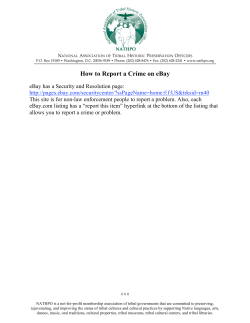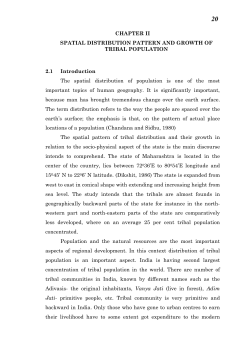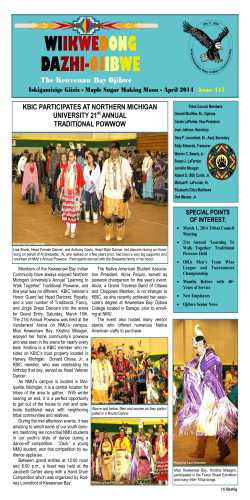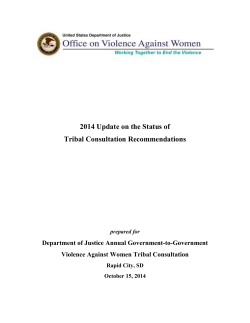
A Study of Socio-economic and Nutritional Status of the Tribal Children
© Kamla-Raj 2012 Stud Tribes Tribals, 10(2): 183-187 (2012) A Study of Socio-economic and Nutritional Status of the Tribal Children R. Parimalavalli Department of Food Science, Periyar University, Salem 636 011, Tamil Nadu, India E-mail: parimala1996@gmail.com KEYWORDS Poverty. Low Income Group. Scaly Skin. Vitamin A Disorder. Malnutrition. ABSTRACT Tribes are at risk of under nutrition due to poverty and improper health seeking behaviour. Therefore the study was undertaken to assess the socio-economic and nutritional status of the tribal children. A total of 149 tribal children were included for the study. Questionnaire was used to collect data on socio-economic, anthropometric measurements, food intake, clinical signs and symptoms. The results revealed that most of the Velala tribals lived in small size families, belonged to Low Income Group and they were illiterates. Mean height, weight and food intake of the selected tribal children were found to be significantly less than reference values. Their food intake was lacked in many nutrients. Majority of the Velala tribal children had brownish hair and carries tooth. Moreover scaly skin and hypo pigmented Vitamin A disorder were seen between 16 and 18 years. The magnitude of tribal children was suffered from the maladies of malnutrition. INTRODUCTION Tribal population is at a higher risk of under nutrition because of their dependence on primitive agricultural practices and irregularity of food supply. Health is a prerequisite for human development and is an essential component for the well being of the mankind. The health problems of any community are influenced by interplay of various factors including social, economic, biological and political ones. Nutritional status of a population is an important tool to study health of any population. Nutritional status of the population largely depends on the consumption of food in relation to the need and requirement. Some of the studies showed a relationship between the tribal eco-system and their nutritional status (Rao and Rao 1994; Tiwari 2007). The basic problem of the tribal people is poverty. The problems of low standard of living, hunger, starvation, malnutrition, agricultural illiteracy, disease, poor sanitary and housing facilities, etc. are serious compared to the non-tribals (Vasudevachary 2006). Children and their well- being are the basic concerns of every nation. The quality of human resource of any country is largely determined by the quality of its child development which in turn is a reflection of health and nutritional status. Today, India has the highest level of child malnutrition after Bangladesh in South Asia (Sinha 2006). Malnutrition continues to prevail among the schoolers in tribal groups (Riji 2008). Nutrition is one area in which traditional lifestyle of tribals and their lack of awareness plays a major role. Hence an attempt was made to assess the socio-economic and nutritional status of the Velala tribal children who lived at Semmanatham village in Yercaud taluk, Salem District, Tamil Nadu, India. METHODS Study Design and Participants The study was conducted at Semmanatham village in Yercaud taluk, Salem District. Fieldwork was done during the period of 2007 -2008. The Panchayat Union President of the area had been contacted before the purpose of study explained briefly to the tribals. And parental consent was obtained for collecting the tribal children information. One hundred tribal households were selected by snowball method of sampling technique. All children in the age group of 1-18 years were included for the assessment of nutritional status. Pre-tested questionnaire was used to gather data from the parents of children. Information about age, sex, family size, parent’s education, occupational status and monthly income were recorded. Height was measured to the nearest 0.1 cm using an anthropometer rod and weight was measured by an electronic portable weighing scale to the nearest 0.5 kg. Food intake of the tribal children was determined using 24 hour recall method; adequacy of food intake was calculated and compared with Recommended Dietary Intake. They were screened for clinical signs and symptoms by the Physician and these were recorded. Data 184 R. PARIMALAVALLI were processed and analysed using the soft ware Statistical Program for Social Sciences - version 15. Chi-square test was used to assess an association between two categorical variables. Student t-test was used to find the difference between means of two quantitative variables. RESULTS AND DISCUSSION Information on age and sex distribution of the selected children is given in the Table1. Table 1: Age and sex distribution of the selected tribal children Age in years Boys 1-3 4-6 7-9 10-12 13-15 16-18 12 8 12 13 22 16 (14.0) (9.6) (14.4) (15.6) (26.8) (19.2) Total 83 (56) Girls Number 7 (10.5) 7 (10.5) 5 (7.5) 10 (15.0) 20 (30.0) 17 (25.5) 19 (12.7) 15 (10.0) 17 (11.3) 23 (15.4) 42 (28.1) 33 (22.1) 66 (44) 149 Figure in parenthesis indicates per cent As can be seen from the Table 1, the selected tribal children in the age group of 13-15 years were 28.1 per cent followed by 16-18 years (22.1) and 10-12 years (15.4). Regarding sex distribution, 56 percent and 44 per cent of them were boys and girls respectively. This result is confirmed with Chakma et al. (2009) who reported that in tribal population 52 per cent of them were males and 48 per cent of them were females. It is evident from the Table 2, nearly three – fourth of the tribal families had small size family with two to four members. Approximately half of fathers of the selected tribal children were illiterates whereas 28 and 12 per cent of fathers had primary and secondary level education respectively. Minimum number of fathers educated upto higher secondary level education. Majority of mothers (60 per cent) were illiterates followed by 28 and 9 percent of mothers studied upto secondary and primary level education respectively. Economical status of the tribals showed that almost 98 per cent of the selected tribal families’ monthly income was below Rs. 4500. This result is confirmed with the findings of Rekha et al. (2006) who stated that 42 per cent of the respondents had monthly income in the range of Rs. 1001-2000. Only 11 per cent of them reported that their income was more than Rs. 5000. Table 2: Socio-economic distribution of the selected tribal households (n=100) Particulars Family Size Small(2-4 members) Medium(5-7 members) Large(above 7 members) Father’s Education (n=100) Illiterate Primary level Secondary level Higher Secondary level Mother’s Education (n=99) Illiterate Primary level Secondary level Higher Secondary level Monthly Income Below Rs. 4500 Rs. 4500-7500 Above Rs.7500 Number 67 26 7 59 28 32 7 62 28 9 98 2 - Table 3 shows that an association between occupation and economic status of the tribal households. A significant association was found between male occupation and economical status because most of the male tribals were labourers. This result is confirmed with the findings of Kodavanti et al. (2006) who indicated that a significant association was observed between under nutrition and socio-economic parameters such as type of family, size of land holding and occupation of head of the household. As tribal economy is predominantly agricultural, nearly 88 per cent of tribal workers employed as cultivators and agricultural labourers, only 5.5 per cent of them occupied as workers in mining and only 3.2 percent engaged in house hold and manufacturing industry (Sinha 2006). Majority of the respondents adopted farming as primary and labour as secondary occupation (Rekha et al. 2006; Riji 2008). Table 4 presents the mean height and weight of the selected tribal children aged from one to 18 years along with the standard deviation and the reference standards of ICMR values corresponding to the age. Statistical analysis revealed that the mean height of the selected tribal children was significantly less when compared with reference values of boys and girls whereas no significant difference was found in the age group of 4-6 and 13-18 years girls. On the other hand, the mean weights of both boys and girls were significantly lower than reference values. Mitashree et al. (2007) reported that the maxi- 185 SOCIO-ECONOMIC AND NUTRITIONAL STATUS OF THE TRIBAL CHILDREN Table 3: Occupational and economical status of the selected tribal households Occupation of the parents Labour Non - Labour * Economical status of the selected households <Rs. 2500 Chi-square value (pooled sample) Rs. 2500-4500 Male Female Male Female Male Female 72 14 52 33 9 5 6 6 29.5* NS - Significant at P <0.05 level, NS- Not Significant mum percentage of underweight was found among boys (95.77%) in the age group of 4-6 years followed by 91.80 per cent girls found to be decreasing with the increasing age. The lowest prevalence of underweight was noticed among girls (15%) in the age group of 10 - 12 years. The highest prevalence of stunting was also found in boys (84.51 per cent ) in the age group of 4 - 6 years but girls showed comparatively lower rate of (47.54 per cent) stunting in the same age group. More than 50 per cent of the children including both boys and girls suffered stunting in the age group of 7-12 years. Kulsum et al. (2009) stated that the number of children belonging to normal categories are very small and a large number lie in the category of mild and moderately malnourished children. Similar results were obtained by Divya et al. (2010) who reported that both urban and rural school children were found to be in varying degrees of undernutrition, the number of children with normal weight, height or BMI was very small across all schools indicating that a large improvement in nutritional status is desirable. The results in Table 5 indicate that cereals and pulses intake of children and adolescents (except16 to 18 years) were not satisfactory and their deficit was less than 20 to 55 percent when compared with Recommended Dietary Intake (RDI). Milk and meat products intake was much less than RDI. Fruits, vegetables, fats, sugar , fish and meat were not common consumption items in the study area. Jyothilakshmi et al. (2005) determined the dietary adequacy of the rural preschool children. Food intake assessed in three different seasons revealed that their diets were predominantly cereal based with negligible quantity of protective foods. Food consumption pattern showed no gender differences and nutrient adequacy also varied by the age of children. Apart from age, nutritional status, availability of food and feeding practices were the factors which influenced the nutrient intake of the preschool children. Similarly Veenakumari (2006) stated that the consumption of nutritious foods like leafy vegetables, oils and fats, fish and meat was still much lower, mainly due to poor purchasing power of households. Clinical manifestations of the selected tribal children in Table-6 indicated that Loss of lustre in hair was seen in 11.1 per cent in the age group of 7-9 years. Dry, rough (22%) and brownish (33%) hair was common between 10 and 12 Table 4: Height and weight of the selected tribal children (n=149) Age (years) Sex Mean Height (cm)±S.D ICMR# 1-3 Boys Girls Boys Girls Boys Girls Boys Girls Boys Girls Boys Girls 73.6±13.1 74.0±11.3 101.6±13.3 105.0±9.2 113.5±3.3 109.5±8.2 134.4±6.7 134.1±1.1 137.5±8.5 139.0±9.0 149.3±9.2 146.5±5.3 89.48 87.41 112.37 111.39 128.27 127.65 143.57 144.96 160.65 154.82 171.15 156 4-6 7-9 10-12 13-15 16-18 ‘t’ value 4.2 ** 3.14 ** 2.28 ** 1.84 NS 15.33 ** 4.94 ** 4.87 ** 31.13 ** 12.71 ** 7.83** 9.49 ** 7.37** # Indian Council of Medical Research (2002) ** – significant at P <0.01 1% level NS – Not Significant Mean Weight (kg)±S.D ICMR# ‘t’ value 8.5 ±2.8 8.2 ±2.4 14.6 ±2.9 15.1 ±1.7 16.14±2.4 14.26±1.1 30.17±7.4 28.88±7.6 31.55±6.9 32.21±6.9 40.16±6.7 36.57±3.5 12.61 11.81 19.20 18.69 26.96 26.71 35.44 37.91 47.76 46.66 57.27 49.7 4.91 ** 3.85 ** 4.42 ** 5.59 ** 15.55 ** 25.31** 2.56 ** 3.76 ** 11.02 ** 9.37 ** 10.21 ** 15.47 ** 186 R. PARIMALAVALLI Table 5: Food intake of the selected tribal children Age (years) Cereals(g) RDI 1-3 Boys Girls 4-6 Boys Girls 7-9 Boys Girls 10-12 Boys Girls 13-15 Boys Girls 16-18 Boys Girls 150 150 Mean Pulses(g) % 69.6 -54 70.7 -53 RDI Mean Fruits and vegetables(g) Fats and sugars(g) % RDI Mean % RDI Mean Milk and meat products(g) % RDI Mean % 137 150 -54 -50 50 50 30 20 -40 -60 80 80 4.6 6.4 -94 -92 50 50 9.6 8.5 -81 -83 300 300 150 150 118 120 -21 -20 50 50 20 19 -59 -61 80 80 14.6 19.7 -82 -75 50 50 9.7 19.7 -81 -61 300 200 78.9 80 -74 -60 250 250 157 135 -37 -46 60 60 20 28 -67 -53 100 100 28.5 11.6 -72 -88 80 80 9 9 -89 -89 200 200 85 23.3 -58 -88 320 320 213 219 -33 -31 60 60 26 22 -56 -63 125 125 34.2 26.3 -73 -79 85 85 2.8 2.4 -97 -97 200 200 90 46 -55 -77 430 350 218 216 -49 -38 70 50 30.5 -56 20.5 -59 130 180 27.6 28.3 -79 -84 70 70 2.1 2.7 -97 -96 150 150 46 25 -69 -83 350 350 322 317 -8 -9 50 50 30.5 -39 21.8 -56 180 180 20.6 19.5 -89 -89 70 70 3.4 2.4 -95 -97 150 150 85 80 -43 -47 % - Percent RDI- Recommended Dietary Intake years. Pale and dull eyes that were the symptoms of anaemia found to be more prevalent among children in the ages of 1-13 years. Carries of tooth was observed in most of the selected tribal children varied from 18.1 to 33.3 per cent. In the present study, angular stomatitis (33%) was existed in the selected tribal children. Scaly skin and hypo pigmented vitamin A disorder were the most dominant disorders ranging from 9 to 50 per cent. Brittle nail (44%) was noticed in the selected tribal children in the age group of 7-12 years. None of the children had spooning of nail. CONCLUSION A study was conducted on 149 children in the age range of 1- 18 years from one hundred tribal households about socio- economic factors and nutritional status. Based on the results of Table 6: Clinical manifestations of the selected tribal children Clinical Assessment Hair Loss of lustre Dry and rough Brownish Eyes Bitot’s spots Squint Anaemia Mouth Mouth ulcer Angular stomatitis Carries tooth Skin Dry and rough Scaly skin Hypo pigmented Vit-A disorder Nails White spots Brittle nail Spooning Age in years (n=149) 1-3 4-6 7-9 10-12 13-15 16-18 - 9.0 11.1 11.1 11.1 22.2 33.3 18.1 27.2 - 66.6 - 11.1 33.3 9.0 27.2 - 33.3 - 9.0 27.2 33.3 11.1 33.3 18.1 - - 9.0 9.0 9.0 11.1 - 11.1 11.1 9.0 18.1 27.2 50.0 50.0 - - 22.0 - 22.0 - 9.0 9.0 - - SOCIO-ECONOMIC AND NUTRITIONAL STATUS OF THE TRIBAL CHILDREN the present study, most of the tribal households had small size family, most of them were illiterates and they belonged to low income group. The selected children were shorter and lighter than the reference population and their food intake was also inadequate. Moreover deficiency symptoms such as brownish –rough hair, anaemia, carries tooth and vitamin A deficiency disorders were seen in the selected tribal children. Majority of the tribal children showed poor growth pattern and they were not at all in good nutritional status. RECOMMENDATIONS It is recommended that essential commodities can be provided at an affordable cost to tribals, food supplements can be given to tribals for preventing some clinical signs and symptoms and creating awareness about nutritional knowledge is essential to improve the nutritional status of tribals. ACKNOWLEDGEMENT The author gratefully acknowledges Malcolm and Elizabeth Adiseshiah Trust, Chennai for the financial assistance. REFERENCES Chakma T, Meshram PK, Rao PV, Singh SB, Kavishwar A 2009. Nutritional status of Baiga- A primitive tribe of Madhya Pradesh. Anthropologist, 11: 39-43. 187 Divya P, Dachana KB, Prakash J 2010. Nutritional status and dietary intake of children from urban and rural schools providing mid-day meal. Ind J Nutr Dietet, 47: 394-403. Jyothilakshmi A, Begum K, Saraswathi G , Prakash J 2005. Dietary adequacy of Indian rural preschool children: Influencing factors. J Trop Paediat, 51: 39-44. Kodavanti M, Nagalla B, Avula L, Kodali V Brahmam GNV 2006. Diet and nutritional status of adolescent tribal population in nine States of India. Asia Pac J Clin Nutr, 15: 64-71. Kulsum A, Jyothilakshmi A, Prakash J 2009. Dietary adequacy of Indian children residing in an urban slumAnalysis of proximal and distal determinants. Ecol Fd Nutri, 48:161-177. Mitashree M, Kumar PV, Chakrabarty C, Bharati 2007. Nutritional status of Kamar tribal children in Chattisgarh. Ind J of Pedi, 74: 381-384. Rao HD, Rao MK 1994. Levels of malnutrition and socioeconomic conditions among Maria Gonds. J Hum Ecol, 5: 185-90. Rekha S, Valeria L, Bindu S, Nandana K 2006. Food and nutrition security of tribal farmers of Ranchi district of Jharkhand. Ind J Nutr Dietet, 44: 407-412. Riji H 2008. Nutritional status of tribal and non-tribal preschoolers. Ind J Nutr Dietet, 45: 102 - 105. Sinha A 2006. Economic empowerment and amelioration of tribals in India. Kurukshetra- A Journal in Rural Development, 54: 3-11. Tiwari DN 2007. Growth and nutritional status of the Bharia-A primitive tribe of Madhya Pradesh. Coll Antropol, 31: 95-101. Vasudevachary AK 2006. Tribal development in Andhra Pradesh. Kurukshetra- A Journal in Rural Development, 54: 33- 36. Veenekumari RKP 2006. Food Security in rural Bihar: A village level study. Journal of Rural Development, 25: 579-594.
© Copyright 2025

















